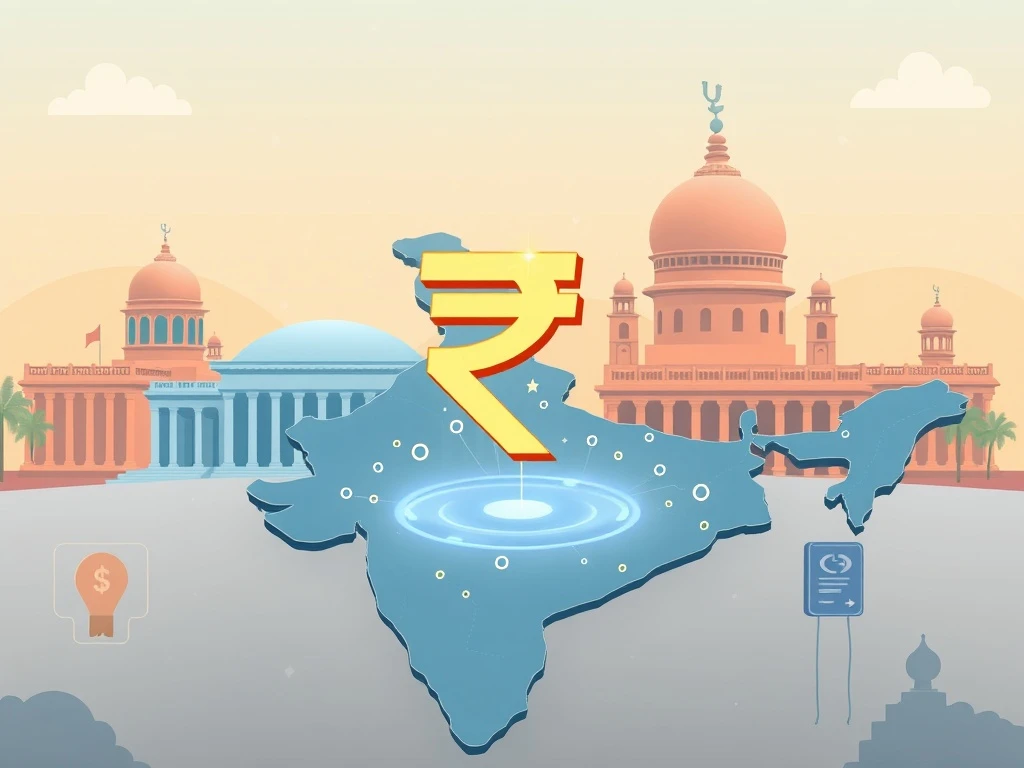India Unveils Revolutionary Digital Currency Amidst Scrutiny of Unbacked Crypto

India stands at a pivotal moment in its financial evolution. The nation is actively embracing digital transformation, with the Reserve Bank of India (RBI) spearheading new initiatives. This move marks a significant step towards modernizing the country’s payment systems. At the same time, India maintains a cautious stance on private cryptocurrencies. The government aims to harness innovation while ensuring financial stability and consumer protection. This dual approach defines India’s journey into the digital finance era, setting a precedent for emerging economies worldwide.
RBI Digital Currency: India’s Strategic Leap into Digital Finance
India is preparing to launch a groundbreaking digital currency. This initiative comes directly from the Reserve Bank of India (RBI). Commerce Minister Piyush Goyal announced this development during a visit to Qatar. The new digital currency aims to simplify transactions across the nation. It promises faster and more transparent financial operations. This project represents a strategic move to enhance India’s economic infrastructure. It also seeks to reduce reliance on physical cash. Furthermore, it intends to improve the efficiency of payment systems, benefiting both individuals and businesses.
The RBI’s chief general manager of the fintech department, Suvendu Pati, also shared significant news. The RBI plans to launch a pilot program for deposit tokenization. This pilot will commence shortly. It marks another step in India’s digital financial journey. The central bank intends to use its wholesale Central Bank Digital Currency (CBDC) as the foundation. This foundational layer will support the deposit tokenization pilot. Several domestic banks will collaborate on this innovative project. Such collaboration highlights a broad commitment to financial modernization and digital innovation within the banking sector.
Commerce Minister Goyal clarified the nature of India’s forthcoming digital currency. He stated it will be backed by the RBI. Its primary goal is to streamline transactions. This new system promises greater speed and transparency than traditional banking methods. Importantly, Goyal distinguished this project from stablecoins. He suggested the RBI-backed system would offer superior efficiency for transactions. It aims to create a robust and user-friendly financial tool for the entire economy. Moreover, this approach ensures sovereign control over the digital asset.
Understanding India’s Digital Currency: Beyond Stablecoins and Unbacked Crypto
Minister Goyal explained the practical benefits of this innovation. “It will only make it easier to transact,” he affirmed. He added that the initiative would reduce paper consumption. Transactions will also become faster than the current banking system. This digital currency will leverage blockchain technology. This ensures transparency and helps prevent illicit transactions. Such features are crucial for building trust and security in the new system. India’s digital currency aims to revolutionize everyday financial interactions, from retail payments to wholesale settlements.
The government’s stance clearly distinguishes its official digital currency from private cryptocurrencies. These private assets, often referred to as unbacked crypto, lack sovereign backing. They do not have the guarantee of a central bank or government assets. This fundamental difference is a cornerstone of India crypto regulation. The RBI’s digital currency offers stability and regulatory oversight. Conversely, private cryptocurrencies operate in a less regulated, often volatile environment. This distinction guides India’s approach to digital assets, prioritizing stability and consumer protection.
The minister reportedly opposed an RBI-backed project on stablecoins. He claimed the new system would facilitate transactions “more easily and efficiently.” This perspective highlights a preference for a direct central bank liability. Stablecoins, while aiming for price stability, often rely on reserves held by private entities. This introduces counterparty risk. India’s choice reflects a desire for a fully sovereign and risk-controlled digital payment instrument. Therefore, the RBI digital currency is designed as a direct extension of the national fiat currency.
India Crypto Regulation: A Nuanced Approach to Taxation
While championing its own digital currency, India expressed skepticism about private cryptocurrencies. Minister Goyal specifically mentioned assets like Bitcoin (BTC). He stated these assets have “no back end guaranteeing any value.” This position underscores the government’s concern over volatility and investor risk. India’s stance on unbacked crypto is clear: caution is paramount. The government differentiates between sovereign-backed digital assets and speculative private tokens. This distinction shapes its regulatory framework.
Goyal emphasized that India has not banned cryptocurrency trading. Instead, the government takes a pragmatic approach. He explained, “Suppose tomorrow there’s no buyer, there’s nobody to guarantee. It’s a thing you can do at your own risk and cost.” This statement highlights the government’s view of crypto as a high-risk investment. It also outlines the individual responsibility involved. Therefore, the government neither encourages nor discourages private crypto. It simply applies a tax. This policy acknowledges the existence of the market without endorsing its underlying assets.
The policy on crypto taxation India is a key aspect of this approach. It allows citizens to participate in the market. Yet, it acknowledges the speculative nature of these assets. India introduced a 30% tax on income from virtual digital assets (VDAs) in 2022. Furthermore, a 1% Tax Deducted at Source (TDS) applies to VDA transactions above a certain threshold. This taxation framework provides a degree of legitimacy. However, it does not imply endorsement. It simply recognizes economic activity. This nuanced stance balances innovation with regulatory oversight. It aims to protect investors while allowing market participation and generating revenue.
Historical Context: RBI’s Enduring Skepticism Towards Unbacked Crypto
The Reserve Bank of India has consistently maintained a skeptical view of cryptocurrencies. These discussions have spanned many years. The central bank has debated imposing an outright ban on crypto transactions in the past. Such concerns stem from issues like market volatility, potential use in illicit activities, and challenges to monetary policy control. The RBI prioritizes financial stability and consumer protection above all else. Its cautious approach reflects these core mandates, ensuring the integrity of the financial system.
In 2018, the RBI imposed a blanket ban on banks dealing with crypto businesses. However, the Supreme Court of India overturned this ban in March 2020. This ruling paved the way for legal crypto trading in the country. Despite this, the RBI continued to express reservations. It consistently highlighted the risks associated with unregulated digital assets. This historical backdrop is crucial for understanding the current India crypto regulation landscape. It shows a persistent effort by the central bank to manage potential threats from private crypto.
The RBI launched its wholesale CBDC India project, the digital rupee, in late 2022. This earlier initiative aimed to improve interbank settlements. It sought to reduce transaction costs within the financial system. This wholesale CBDC laid important groundwork. It demonstrated the RBI’s commitment to digital innovation within a controlled environment. The current pilot programs build upon these foundational efforts. They further solidify India’s push into a digital-first economy. Minister Goyal’s recent remarks align with the RBI’s long-standing position. They reiterate the government’s preference for regulated digital assets.
CBDC India: A Closer Look at Deposit Tokenization and Its Potential
The RBI’s new deposit tokenization pilot is a significant development for CBDC India. This pilot will use the wholesale segment of India’s CBDC. This provides a robust and secure underlying technology. Deposit tokenization involves converting traditional bank deposits into digital tokens. These tokens can then be transferred and settled more efficiently. This process promises to enhance the speed and security of interbank transactions. It also aims to reduce settlement risks and operational complexities within the financial system.
Several domestic banks will participate in this pilot. Their involvement is crucial for its success. This collaboration ensures real-world testing and feedback. The pilot aims to demonstrate the practical benefits of tokenized deposits. It could lead to a more streamlined financial system. Such innovation could reduce operational costs for banks. It could also improve liquidity management. This forward-thinking approach positions India as a leader in digital financial infrastructure. Furthermore, it lays the groundwork for future advancements in financial technology.
The implications of successful deposit tokenization are vast. It could pave the way for new financial products and services. It might also foster greater financial inclusion. By leveraging blockchain technology, the system ensures transparency. It also enhances traceability. This helps in preventing fraud and ensuring compliance. The RBI’s commitment to exploring these advanced concepts is clear. They are building a resilient and modern financial ecosystem. This move could potentially transform how financial institutions interact and conduct business, leading to a more efficient and secure environment.
Global Parallels and the Future Outlook for India Crypto Regulation
India’s journey mirrors similar efforts worldwide. Many central banks are exploring or launching their own CBDCs. Kazakhstan, for instance, has discussed its digital tenge. It distinguishes its CBDC from stablecoins. This global trend highlights a collective move towards digital sovereignty in finance. Nations seek to modernize their financial systems. They also aim to retain control over their monetary policy. India’s approach fits well within this international landscape, learning from and contributing to global best practices.
The ongoing debate between CBDCs and stablecoins remains prominent. CBDCs are central bank liabilities. They represent direct claims on the central bank. Stablecoins, however, are typically issued by private entities. They aim to maintain a stable value against a fiat currency or other assets. India’s preference for an RBI digital currency over private stablecoins is consistent. It aligns with a desire for sovereign control and stability. This distinction is crucial for understanding India’s regulatory philosophy and its future direction in digital finance.
Looking ahead, India’s digital currency initiatives could reshape its economy. They promise more efficient transactions and reduced paper use. The cautious stance on unbacked crypto also provides clarity for investors. It outlines the risks and responsibilities involved. As the pilots progress, the world will watch India’s financial innovation. The nation is building a future where digital finance thrives under careful regulation. This balance ensures both growth and stability in its burgeoning digital economy. India’s strategic steps will likely influence other nations grappling with similar challenges in the digital age.









